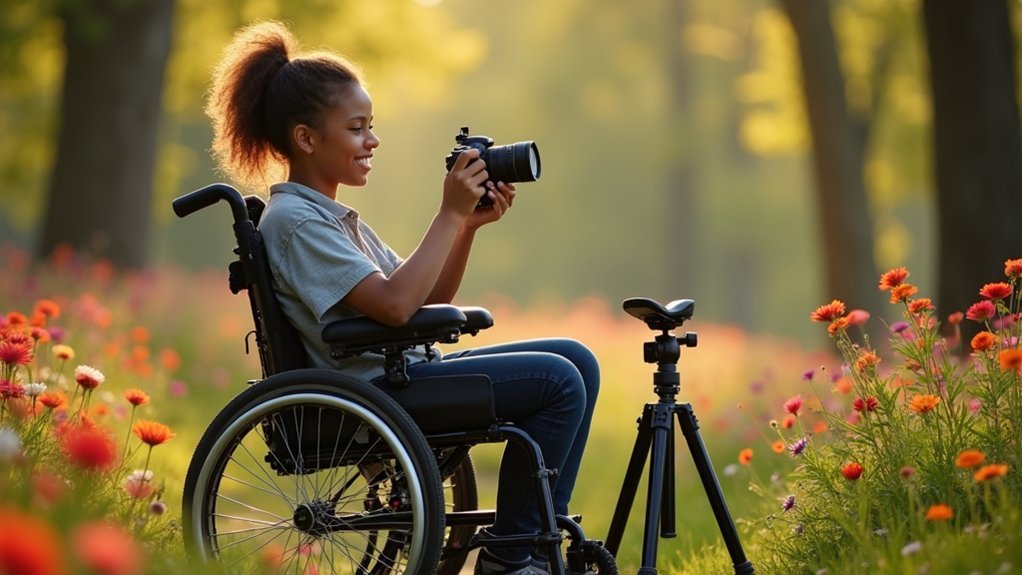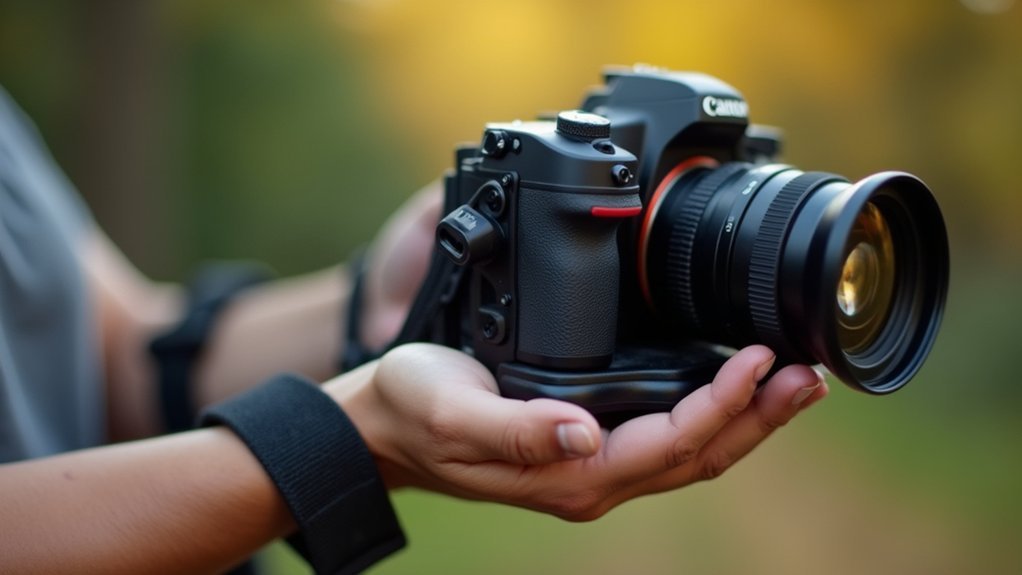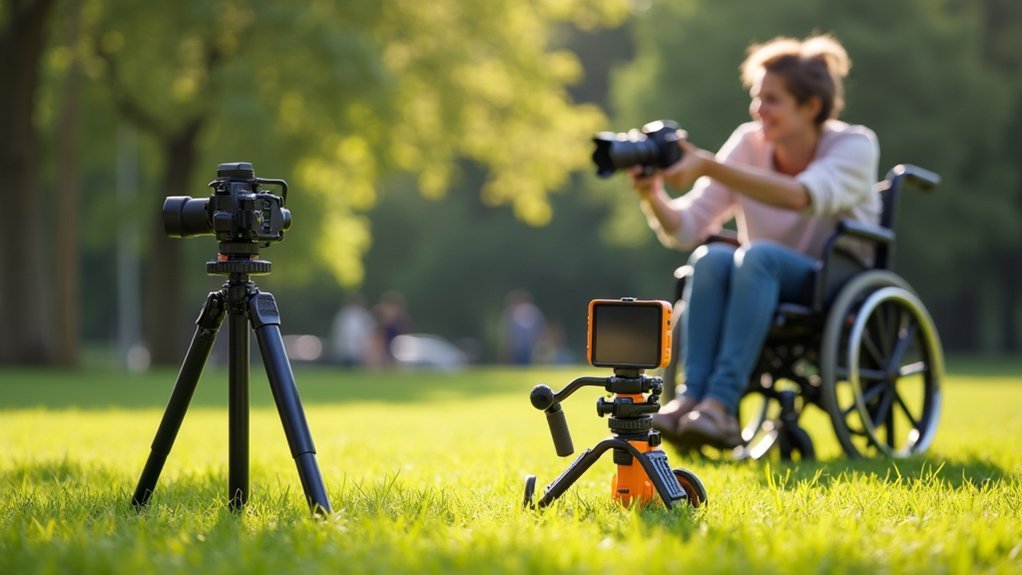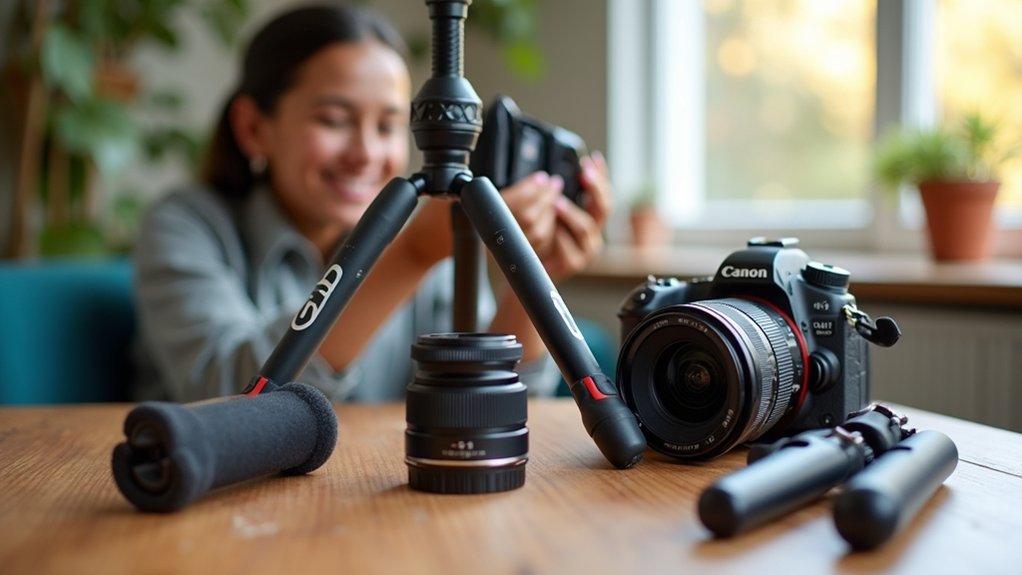Photography can be accessible for those with cerebral palsy through specialized equipment. Consider switch-accessible cameras with large buttons, wheelchair-mounted stabilization systems, and Bluetooth-enabled remote triggers. Voice-activated controls eliminate the need for manual operation, while custom mounts secure equipment at comfortable angles. Ergonomic grips and harnesses distribute weight evenly to reduce fatigue. Image stabilization technology compensates for natural movements, ensuring clearer photos. The following tips will transform your photography experience regardless of mobility challenges.
7 Tips: Photography Tools For Cerebral Palsy

While photography offers a powerful medium for artistic expression, individuals with cerebral palsy often need specialized tools to fully engage with this art form. Adapted cameras with high resolution and zoom capabilities can make capturing images easier when mobility is limited.
Consider switch-accessible cameras with large buttons that accommodate dexterity challenges. For those with significant mobility limitations, eye-tracking technology shows promising potential for camera control.
Don’t overlook assistive mounts to stabilize equipment and adaptive grips for more secure handling. The Adapted Digital Camera features 12.0 MP resolution and 5x digital zoom for high-quality image capture. Look for cameras with simplified interfaces and pre-set modes that reduce the need for manual adjustments.
Photography software with accessibility features can also help with post-processing. Remember that these tools aren’t just about technical assistance—they’re gateways to creativity, independence, and emotional expression.
Adaptive Camera Mounts and Stabilization Systems
Adaptive camera mounts with flexible joints allow you to position your equipment at comfortable angles, making photography more accessible despite motor challenges from cerebral palsy.
You’ll find hands-free operation systems particularly valuable when dexterity issues limit your ability to press buttons or hold a camera steady. Consider CanAssist’s specially designed camera that offers single-button operation for users who struggle with traditional camera controls.
Wheelchair-mounted solutions can transform your mobility aid into a mobile photography studio, with custom attachments that secure your camera while maintaining stability during movement.
Flexible Joint Positioning
Three essential features make flexible joint positioning systems invaluable for photographers with cerebral palsy.
First, the flexible arms allow you to position your camera at virtually any angle without straining your body. You’ll find these adjustable mounts particularly helpful when you need to capture shots from unconventional perspectives. Some advanced designs include a swiveling head bracket that allows for a full 180-degree rotation, perfect for self-portraits.
Second, these systems offer user-friendly adjustment options for height and angle, enabling you to customize your setup for different photography scenarios. You won’t need extensive physical effort to reposition your camera between shots.
Finally, switch-accessible buttons integrated into these mounts let you take pictures with minimal joint strain. Many systems can be paired with adaptive joysticks for easier control if you have limited dexterity.
This technology effectively transforms photography from a physically demanding activity into an accessible creative outlet.
Hands-Free Operation Systems
Hands-free operation systems represent the next level of accessibility for photographers with cerebral palsy.
Adaptive camera mounts secure your equipment on tripods or specialized arms, providing stability when dexterity is limited. These mounts can be customized to address your specific needs.
For greater control, consider switch-accessible cameras that operate with large buttons or external switches. Many utilize standard 3.5mm inputs, ensuring compatibility with various accessibility devices. The Bluetooth-enabled camera shutter allows for convenient photo taking through adaptive switch activation, promoting independence for individuals with limited dexterity.
Motorized pan and tilt heads allow smooth camera adjustments without manual manipulation.
Stabilization systems greatly reduce camera shake, producing clearer images despite movement challenges.
For maximum control, explore camera mounts designed for robotic arms or motorized systems that can be operated through Bluetooth connections, joysticks, or mouth-operated devices—giving you creative freedom despite physical limitations.
Wheelchair-Mounted Solutions
For photographers who use wheelchairs, specialized mounting solutions offer unprecedented creative freedom.
Standard mounting holes on adaptive cameras allow you to secure them to your wheelchair, creating a stable platform for independent shooting.
Look for mounts with adjustable arms that let you position your camera at the perfect angle.
These versatile attachments are designed to work with various camera models and wheelchair types, with customization options for your specific setup.
To reduce camera shake, consider additional stabilization techniques.
While external stabilizers can be adapted for wheelchair use, many cameras feature built-in gyroscopic stabilization.
The Eyegaze Edge system’s ability to function at various angles can complement camera positioning for photographers with cerebral palsy.
You can also employ slower shutter speeds or burst mode to capture clearer images despite movement.
For post-processing, photo editing software can correct minor motion blur.
Custom Triggers and Remote Shutter Options
Wireless shutter solutions offer you hands-free control of your camera through smartphone apps or remote triggers that can be positioned anywhere within reach.
Mouth-operated release controls provide an innovative option when hand mobility is limited, allowing you to capture images by applying gentle pressure with your lips or breath.
These specialized triggers can transform your photography experience, giving you creative independence despite physical challenges associated with cerebral palsy. Similar to typing aids which are fastened with velcro, these photography tools can be customized to accommodate individual mobility needs.
Wireless Shutter Solutions
When motor control challenges make pressing a traditional camera button difficult, wireless shutter solutions offer game-changing possibilities for photographers with cerebral palsy.
These Bluetooth-enabled devices connect easily to smartphones, tablets, and cameras while accepting inputs from adaptive switches tailored to your specific needs.
- Bluetooth shutter buttons pair instantly with your devices, requiring no complex setup
- 3.5mm input jacks accept standard accessibility switches positioned where you can access them comfortably
- Dual activation options let you or your support person trigger the camera in multiple ways
- Low-latency connections guarantee responsive photography without frustrating delays
- Custom mounts and straps secure these controls to wheelchairs or other assistive equipment
You’ll gain independence in capturing photos while eliminating camera shake that often compromises image quality. These systems mirror the functionality of the wireless remote that has enabled photographers with limited motor control to successfully capture diverse subjects from event protests to stunning landscapes.
Mouth-Operated Release Controls
Liberation comes through mouth-operated release controls, giving photographers with cerebral palsy precise shutter control without requiring hand dexterity. Your tongue’s motor cortex representation rivals your fingers, offering exceptional precision while resisting fatigue during extended photo sessions.
Custom triggers can be tailored to your specific abilities—whether you prefer sip-and-puff mechanisms or bite-activated switches. These integrate seamlessly with most cameras via wired or wireless connections to remote shutter ports. These devices significantly contribute to enhancing independence for individuals with cerebral palsy by allowing creative expression through photography.
For ideal performance, consider addressing any oral restrictions that might limit tongue mobility. Professional assessment can help enhance your setup’s sensitivity and activation pressure.
When properly configured, these controls enable complete creative autonomy, allowing you to capture spontaneous moments independently while maintaining your artistic vision—regardless of positioning constraints.
Ergonomic Grips and Harnesses for Camera Support

For photographers with cerebral palsy, specialized ergonomic grips and harnesses represent a game-changing advancement in accessibility.
These supports distribute weight evenly across your body, reducing fatigue and strain during extended photography sessions while providing essential stability. The Grey Skout G2 and CCS G3 Grey Harness offer professional-grade materials that ensure durability during active photography pursuits.
Ergonomic camera supports eliminate physical barriers, letting photographers with CP focus on their creative vision, not their limitations.
- Enhanced stability – Helps manage tremors and involuntary movements common with cerebral palsy
- Customizable fit – Adjustable straps accommodate different body types and mobility levels
- Pain reduction – Alleviates neck, shoulder and back strain through proper weight distribution
- Increased shooting time – Comfortable design lets you photograph longer without discomfort
- Versatile compatibility – Works with various camera types and can often integrate with backpacks
When selecting a harness, prioritize adjustability, durable materials, and ergonomic design to support your specific needs.
Voice-Activated Photography Equipment
Voice-activated photography equipment offers a revolutionary solution for photographers with cerebral palsy, eliminating the need for precise manual control.
With simple commands like “take photo” or “start recording,” you’ll capture moments without struggling with buttons or settings.
These cameras use advanced speech recognition to understand your instructions, with many models allowing customizable commands to suit your specific needs.
The hands-free operation provides independence for those with limited dexterity while reducing distractions during shoots.
Voice-tracking cameras can automatically detect and focus on speakers, ideal if you’re creating instructional content or recording events.
This technology maintains proper framing even as you move, ensuring professional-quality results.
Look for models with smartphone integration and wireless connectivity for seamless photo management and sharing.
These devices significantly improve accessibility for photography, making image capture possible for individuals with mobility challenges who would otherwise struggle with traditional camera equipment.
Tripod and Positioning Solutions for Different Mobility Levels

Choosing the right tripod and positioning equipment dramatically transforms photography accessibility for individuals with cerebral palsy.
For those with cerebral palsy, appropriate positioning equipment doesn’t just enable photography—it unlocks creative expression previously deemed impossible.
Whether you’re using a wheelchair or have variable mobility, customized solutions can support your photography journey while accommodating your specific needs.
- Wheelchair-integrated mounts provide stability without requiring manual holding, with controls positioned within your reach.
- Adjustable tripods with quick-release mechanisms allow easier repositioning and accommodate different postures.
- Switch-adapted mounts enable shutter control via accessible switches when hand manipulation is challenging.
- Positioning solutions with consistent placement landmarks help maintain framing despite limited postural control.
- Lightweight, flexible tripods with locking joints reduce vibration while allowing setup on uneven surfaces or wheelchair footrests.
Chad Madson has found great success with a custom-made tripod specifically designed to attach securely to his wheelchair.
Image Stabilization Technology and Anti-Shake Features
Image stabilization technology serves as a game-changer for photographers with cerebral palsy, directly addressing the hand tremors and involuntary movements that often challenge clear image capture.
Both optical image stabilization (OIS) in lenses and in-body image stabilization (IBIS) work by counteracting your natural movements, allowing you to shoot at slower shutter speeds while maintaining sharpness.
For your specific needs, look for cameras with advanced IBIS systems that compensate along multiple axes. When paired with OIS lenses, you’ll achieve even greater stability. Digital Image Stabilisation can provide an additional layer of correction through software algorithms when optical solutions aren’t enough.
These features are particularly valuable when you’re shooting in low light or using telephoto lenses, which amplify any shakiness. While stabilization won’t eliminate all movement effects, especially with fast-moving subjects, it notably increases your chances of capturing clear, professional-quality images without requiring perfect stillness.
Frequently Asked Questions
How Can Photography Help With Cognitive Development in Cerebral Palsy?
Photography enhances your cognitive abilities by encouraging emotional expression, building problem-solving skills, improving memory recall, developing creativity, and increasing attention span. You’ll learn to focus while expressing yourself visually through this engaging medium.
Can Insurance Cover Specialized Photography Equipment for Cerebral Palsy?
Insurance may cover specialized photography equipment if it’s documented as medically necessary for your CP treatment. You’ll need a prescription, detailed justification from healthcare providers, and possibly prior authorization from your insurer.
What Photography Genres Work Best for Beginners With Cerebral Palsy?
Try outdoor photography in accessible locations, portraiture with family, and documentary photography to track progress. You’ll find these genres build confidence while allowing creative expression despite mobility challenges. They’re rewarding starting points!
How Do Weather Conditions Affect Outdoor Photography With Mobility Aids?
Weather affects your outdoor photography with mobility aids through stability challenges in wind, slippery surfaces in rain, and reduced dexterity in cold. You’ll need gear protection and may benefit from WeatherPods for shelter.
Are There Photography Competitions Specifically for Photographers With Disabilities?
Yes, you’ll find dedicated competitions like those from the Disabled Photographers’ Society, the European Disability Forum’s accessibility-focused contest, and the “This-Ability” Photography Award that showcase disabled photographers’ unique perspectives and talents.
In Summary
You’ve now got seven practical tools to make photography accessible despite cerebral palsy. Whether you’re using adaptive mounts, custom triggers, ergonomic grips, voice commands, specialized tripods, or stabilization technology, don’t let mobility challenges stop you from capturing beautiful images. With these adaptations, you’ll find photography isn’t just possible—it’s enjoyable. Remember, the right equipment transforms limitations into creative opportunities behind the lens.





Leave a Reply